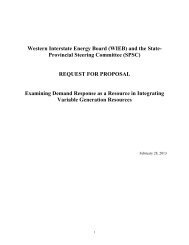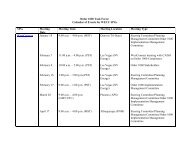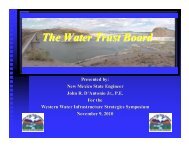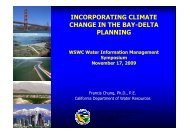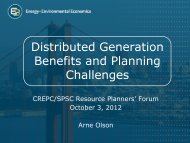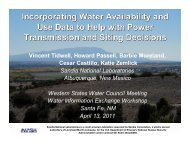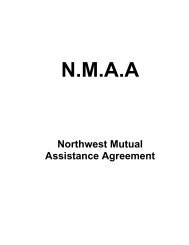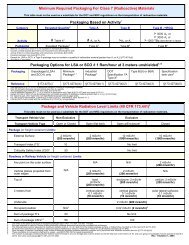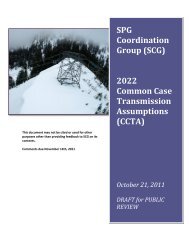WRAT Final Briefing Paper - Western Governors' Association
WRAT Final Briefing Paper - Western Governors' Association
WRAT Final Briefing Paper - Western Governors' Association
You also want an ePaper? Increase the reach of your titles
YUMPU automatically turns print PDFs into web optimized ePapers that Google loves.
such as LSE and generator reporting obligations, combat possible market power abuses and<br />
provide necessary information so that an independent ISO and RTO can operate the system<br />
reliably. 14 The point of enforceable resource adequacy requirements is to create explicit and<br />
clear expectations to overcome perceived problems of regulatory and market forces.<br />
Imposition of standards will move toward eliminating scarcity from the market, and will<br />
reduce the “scarcity rents” that theoretically were to have provided an incentive for private<br />
investors to build new capacity. In lieu of this suppliers will compete to provide the forward<br />
commitments that will allow the LSEs to comply with adequacy standards.<br />
IV.<br />
<strong>Western</strong> Region Resource Adequacy Highlights<br />
In this section we briefly review highlights of various actions that are being considered or<br />
taken that could affect the future adequacy of resources in the West. Those highlighted include<br />
FERC, NERC, selected states, BPA, NWPCC, NWPP, and WECC. This description does not<br />
yet cover all activities and should be considered a work-in-progress, since the field of activity<br />
is on the increase and unfolding rapidly.<br />
IV.A FERC<br />
Although there is uncertainty about FERC’s current statutory authority to regulate reliability,<br />
they have engaged in the state-federal dialogue on resource adequacy and have discussed key<br />
issues in their “Regional Choices” staff paper issued in July 2003. 15 This paper noted the<br />
importance of each region developing a regional resource adequacy plan. It further noted that<br />
to meet a region’s resource adequacy requirement, “….each state could rely on its own state<br />
authority to ensure that each utility or other LSE owns or contracts for enough reserves,<br />
whether generation or demand response, to satisfy its share of the regional need.”<br />
In January of this year the FERC Chair Pat Wood described reliability as the “top item” for the<br />
Commission after the August ’03 blackout. Fifteen million dollars has been appropriated for<br />
FERC activities related to reliability in the Energy and Water Appropriations bill. Wood also<br />
confirmed that FERC is in the process of setting up a new reliability division within the Office<br />
of Markets, Tariffs, and Rates, which will be staffed by up to 30 engineers and technicians.<br />
14 Even this scope of enforceable standards is not considered sufficient by some. Because of concerns that<br />
participants will schedule inaccurately, given CAISO responsibility to dispatch resources to maintain minimum<br />
operating reserves or serve load, the CAISO has proposed to California regulators that any resources nominated<br />
as part of an LSE resource adequacy demonstration would be subject to CAISO dispatch instructions. 14 Many<br />
parties are not willing to have the CAISO dispatch their resources. In particular, LSEs with energy limited<br />
generation and demand response resources are extremely reluctant to allow these resources, planned for use to<br />
minimize LSE-specific costs of serving loads, to be used for the benefit of the overall control area. D.04-01-050<br />
does not accept the CAISO proposal.<br />
15 Federal Energy Regulatory Commission Staff <strong>Paper</strong> on Regional Choices, July 7, 2003 pages 24-25.<br />
14<br />
<strong>Final</strong> Consensus Draft<br />
Westwide Resource Assessment Team



